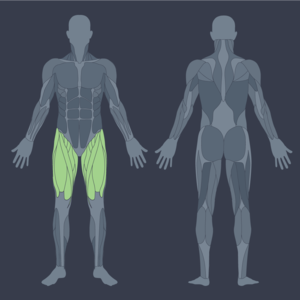
Leg Extension: Muscoli
As already stated in other articles, the lower limbs are made up of numerous muscles
The main ones, and that we all know, are:
- Quadricipiti: in turn composed of vast internal, vast external, rectus femoris
- Sartorio
- Gracile
- Adductors
- Tensor of the fascia lata.
From the posterior lodge of the lower limbs we have:
Gluteus, consisting of the small, medium and large gluteus
- Biceps femoris
- Semitendinosus
- Semimembranoso
- Twins (calves)
Obviously, each of these muscles can be trained using various and specific exercises.
- To fully train the legs, the mother exercise is the squat, as we all know.
- To train the posterior muscles of the lower limbs the best exercises are: deadlifts with straight legs, free body (performed with the use of dumbbells, barbells, kettlebells, etc.), leg curl using machines.
- To train the quadriceps the best exercises are: lunges, bodyweight (performed using dumbbells, barbells, kettlebells, etc.), leg extensions, with the use of machines.
How is it done?
Let's now analyze the “leg extension”, its correct executions, the muscles involved and the common errors and variants associated with it.
For a correct execution, sit on the appropriate machine, back well adherent to the backrest, especially the lumbar spine, the back of the knee resting on the edge of the bench so as to allow the complete excursion of the knee; the upper part of the ankles under the appropriate padding.
Having assumed the correct position, lift the weight until it reaches 90 °; it is very important not to force the joint further. Slowly return to the starting position with maximum weight and movement control. If it is used as a rehabilitation exercise, avoid using excessive loads and working with variations in ROM (range of motion).
This exercise is very specific for the quadriceps muscle and the advantage of using the machine lies in the benefits found in this area, with a significant reduction in the percentage of risk.
It is important to remember that the three single-joint garments always work in synergy, therefore all in the same way; as regards the anterior rectus, biarticular, to increase its work more it is sufficient to tilt the backrest to a greater extent backwards.
Common mistakes
The most common mistakes made in this exercise are:
- Arch the lumbar spine to aid execution
- Perform the momentum movement to aid in the movement
- Performing incomplete movements
- Block the movement by tapping on the counterweight
- Use excessive or too light loads
This machine can be used by both inexperienced athletes (considering the ease of execution of the use of the machine and the low risks that arise from it), both by more advanced athletes.
To increase the level of difficulty, in addition to the load, it is possible to increase the TUT (time under tension) or to perform the exercise one limb at a time.
It is important to remember that flexing or fully extending the foot does not involve particular changes in the muscles.
There are several variations of this machine. The best, from my point of view, is the free leg extension that can be loaded with plates at will where you can work with alternating legs so as to keep a continuous and constant tension on both limbs, avoiding imbalances between the two limbs.
variants
There are several variations to the classic execution and they are:
- Leg extension inclined backrest: keep the backrest slightly inclined, to increase the work of the anterior rectum.
- Leg extension inner toes: the toes turned inwards, the muscles involved are the same but in this case it is possible to slightly increase the muscular work of the vast external ones. The important thing in this variant is not to rotate only the tip of the foot, but also the thigh and hip inwards, so that the vastus medialis rests slightly on the bench. It becomes clear that a slightly lighter load should be used. Excellent variant to improve, if any, ligament weaknesses.
- Leg extension external toes: toes pointing inwards, the muscles involved are the same but in this case it is possible to slightly increase the muscular work of the medial vastus and reduce the work of the external vastus, which will continue to work anyway. In this variant, the rotation of the foot and hip must take place outwards. Use lighter loads. Excellent variant for rehabilitation exercises.
- Single leg leg extension: this variant is performed as the previous ones but here first one limb and then the other alternate. Excellent for developing the muscles of the lower limbs, because it prevents the stronger leg from helping the weaker leg. Excellent variant to rehabilitate the limbs.
- Leg extension with use of cables.
- Leg extension with use of anklets.
- Leg extension with use of a medicine ball or dumbbells.
Conclusions
Training the lower limbs is very important as they are used to support and push the body during walking.
Furthermore, a good muscular structure of the vastus, especially the medial, allows to preserve the health of ligaments and joints.


























